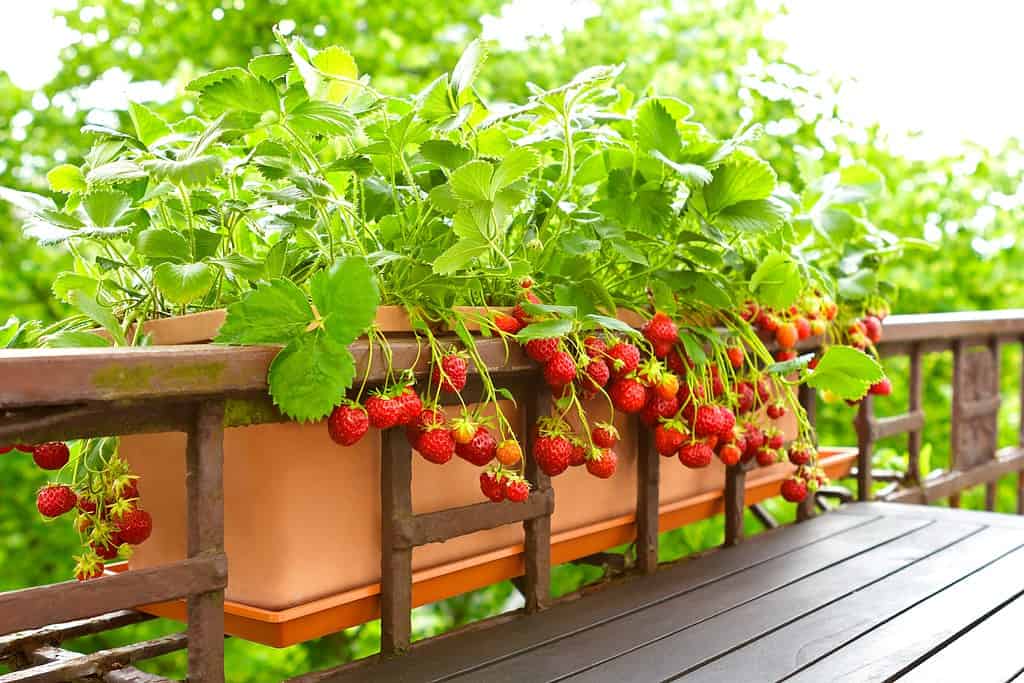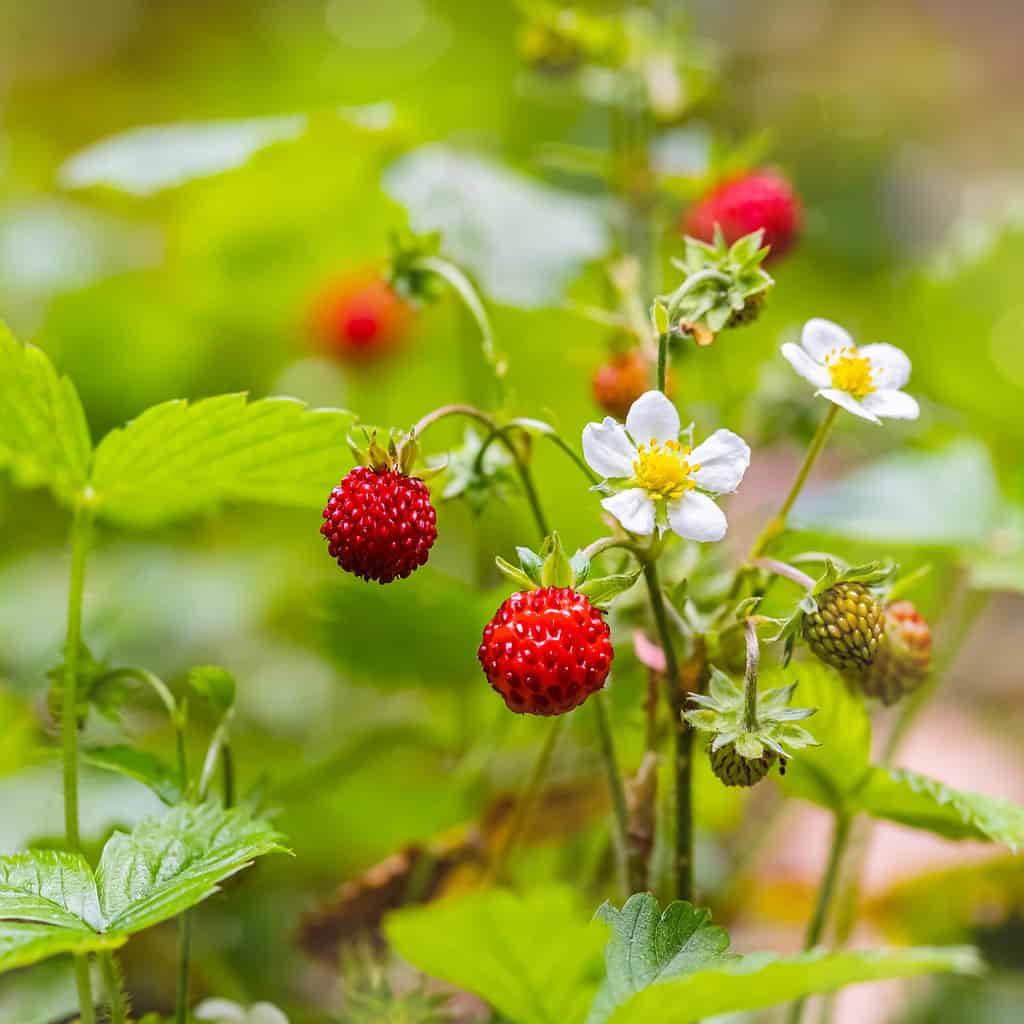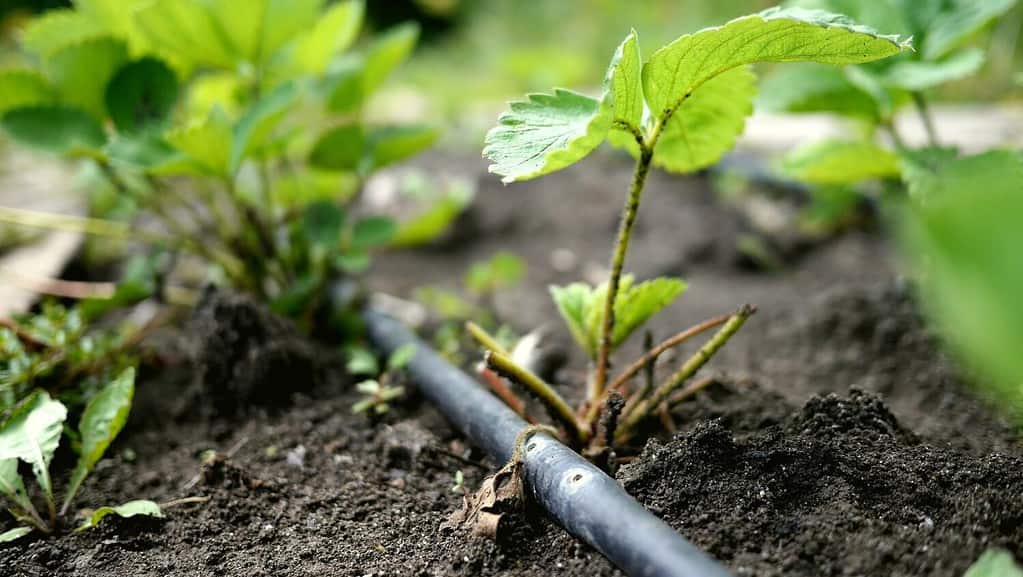The state’s salty soil and dry climate can make growing strawberries in Arizona tough. Fortunately, gardeners who work with the local aridity and use proven growing tips can help Arizona strawberry plants thrive. It’s also important for growers to know the ideal timing for planting and harvesting strawberries in the Grand Canyon State.

Learning about Arizona’s climate Zones helps gardeners determine which plants will thrive locally year-round.
©U.S. Department of Agriculture / CC0 – License
Ideal Timing for Strawberry Planting
Growing strawberries in Arizona starts with planting between mid-March and mid-January, depending on the climate Zone. Learning about the state’s climate Zones helps gardeners determine which plants will thrive locally year-round. More specifically, The University of Arizona Cooperative Extension explains that learning about the local climate Zones can help growers do the following:
- Understand a location’s temperature limitations
- Choose the best plants for successful growth in the local climate
- Determine the lowest average temperatures and whether early freezes are common
- Identify the average soil quality and exposure to extreme conditions
All climate Zones are influenced by elevation and rainfall. The three main landform regions, or climate zones, in Arizona are:
- The Colorado Plateau (North)
- The Transition Zone or Central Mountains (Central)
- The Basin and Range (South)
Using a Climate Zone Map is helpful when determining the best timing for planting any plants in any state. One of the best maps for this purpose is the USDA Hardiness Zones map.
Arizona Hardiness Zones
The USDA Hardiness Zones in Arizona span from Zone 4a through Zone 10b. These planting Zones are grouped by their average lowest winter temperatures. So, the ideal timing for planting strawberries in each Zone can vary between the warmest and coolest regions.
As you can see in the table below, while you would plant strawberries in the spring in Zone 5b, it’s best to plant strawberries in the winter or fall in Zones 9a–10b.
| USDA Hardiness Zones | Strawberry Planting Timing |
|---|---|
| Zone 4a | Spring: Mid-April to Early May |
| Zone 4b | Spring: Mid-April to Early May |
| Zone 5a | Spring: Mid-March to Early April |
| Zone 5b | Spring: Mid-March to Early April |
| Zone 6a | Spring: Mid-March to Early April |
| Zone 6b | Spring: Mid-March to Early April |
| Zone 7a | Spring: Mid-March to Early April Fall: Mid-Sept to Mid-Oct |
| Zone 7b | Spring: Mid-March to Early April Fall: Mid-Sept to Mid-Oct |
| Zone 8a | Spring: Mid-March to Early April Fall: Mid-Sept to Mid-Oct |
| Zone 8b | Spring: Mid-March to Early April Fall: Mid-Sept to Mid-Oct |
| Zone 9a | Winter: Mid-to-late January Fall: Mid-Sept to Mid-Oct |
| Zone 9b | Winter: Mid-to-late January Fall: Mid-Sept to Mid-Oct |
| Zone 10a | Winter: Mid-to-late January Fall: Mid-Sept to Mid-Oct |
| Zone 10b | Winter: Mid-to-late January Fall: Mid-Sept to Mid-Oct |
Growing Strawberries by Elevation
If you know your local Arizona elevation, you can use this information to determine your planting schedule too. This detail is important to know in order to plant strawberries when the weather is cool and the soil is still workable.
- Above 3,000 Feet: Plant strawberries in the spring between mid-March and mid-May.
- Below 3,000 Feet: Plant strawberries in the fall between mid-September and mid-November
It’s also essential to know that the ideal timing for growing strawberries in Arizona depends on the plant type and variety. We will discuss the various strawberry plants later in this article, so read on!

Arizona soil might be too salty for strawberry plants unless the soil is amended for better nutrient content and pH balance.
©V_Sot_Visual_Content/Shutterstock.com
The Best Arizona Regions for Successful Strawberry Plants
Worry not, Arizonans! You can grow strawberries in most regions of the state. Though you will likely need to amend your soil and grow plants in raised beds or containers, it can be done. As long as you provide your plants with optimal care, your strawberry yields can be healthy and abundant.
The Best Region: Planting strawberries in Arizona’s North, Northeast, and Central regions will likely be the easiest and produce the best results. These regions include the Colorado Plateau and Central Mountains (Zones 4a–8b), where the temperatures are generally cooler than in southern regions.
The Worst Region: Arizona’s low and high deserts (Zones 9a–10b) are the most challenging regions for growing strawberries in Arizona. The very high summer temperatures in this region can kill the plants. However, strawberries can do well as annual plants in the low desert if given ample water and afternoon shade.
Best Types of Strawberries Per Region
According to the University of Arizona Cooperative Extension, the following types of strawberry plants grow best in these regions:
- Northern Arizona: June-bearing and day-neutral strawberries should grow well in the Colorado Plateau climate. Everbearing strawberries also grow well in this region’s higher elevation, but plan to keep them from producing fruit until late in the first growing season.
- Central Arizona: All three types of strawberries should do well in the Transition Zone. However, note that day-neutral varieties only thrive as long as temperatures stay below 90 degrees.
- Southern Arizona: June-bearing varieties are the best choice for the warmer climate of the Basin and Range regions in south Arizona. Unfortunately, everbearing and day-neutral plant types struggle in the high heat typical of this region. Also note that all strawberries grown in this hotter region benefit from afternoon shade during high-heat days.
If you need to familiarize yourself with the three main strawberry plants and their differences, keep reading! We’ll discuss the common types of strawberries and the best Arizona varieties below.

The best types of strawberries to grow in Arizona can vary per region, but all three types can thrive in Central Arizona.
©Agenturfotografin/Shutterstock.com
Which strawberry plants grow best in Arizona?
It’s essential to learn about the three main types of plants before growing strawberries in Arizona.
- June-bearing Strawberries: Produce one large crop per growing season, typically in June or July
- Everbearing Strawberries: Produce berries 2-3 times per growing season
- Day-neutral Strawberries: Produce berries throughout the growing season, as long as temperatures stay below 90 degrees Fahrenheit
As for the best strawberry varieties that grow in Arizona, see the table below for ideal plants for Arizona climates.
| Strawberry Variety | Strawberry Type | Best AZ Region | Peak Season |
|---|---|---|---|
| Camerosa | June-bearing | Any region | June and July |
| Chandler | June-bearing | Any region | June and July |
| Earliglow | June-bearing | Any region | June and July |
| Eversweet | Everbearing | Central | Spring and Fall |
| Flavorfest | June-bearing | Any region | June and July |
| Quinault | Everbearing | Central | Spring and Fall |
| Sequoia | June-bearing | Any region | June and July |
| Sweet Kiss | Everbearing | Central | Spring and Fall |
| Tioga | June-bearing | Any region | June and July |
| Tristar | Everbearing | Central | Spring and Fall |

Removing the first round of blossoms from your strawberry plants within the first 3–4 weeks can help them produce more berries overall.
©nnattalli/Shutterstock.com
10 Helpful Tips for Growing Strawberries in Arizona
1. Grow strawberry plants in containers or raised beds.
Because strawberries will likely struggle to survive in Arizona soil, it’s ideal to grow them in raised beds or containers. This way, you can plant strawberries in soil prepared for optimal growth.
That said, flat garden beds might be easier to leach in order to remove excess salt found in Arizona soil. For more information on how to leach your strawberry beds, see tip #3 below.
Also, keep in mind that Arizona’s dry heat will dry out soil in containers very quickly. Adjust your watering schedule and quantity to accommodate container gardening in this climate.
2. Prepare your soil 6-8 weeks in advance of planting.
Strawberry plants love sandy loam soil with plenty of organic matter. So, preparing your soil with these crucial elements will help ensure a healthy yield.
The University of Arizona Cooperative Extension recommends the following steps for preparing soil for strawberry plants:
- Add your soil to the garden bed or containers with a 12-inch layer of organic matter on top. The best organic matter could include compost with decayed leaves, bagged steer manure, and grass clippings. Ensure any animal manure is properly hot-composted first to avoid possible toxins and weed seeds.
- Allow weeds to grow in your prepared soil, and then remove them before planting strawberries.
- Consider adding ammonium phosphate to the soil for optimal nitrogen and phosphorus content. You can add three pounds per 100 square feet. You may also want to amend the soil with sulfur (3-5 pounds per 100 square feet) if the pH level is above 7.5.
- Give your newly amended soil a deep watering to help it settle.
3. Leach your strawberry beds every 6–8 weeks.
Leaching a garden bed is the process of adding extra water to move salt and soluble chemicals out of the top layer of soil. This process is especially beneficial for strawberry plants growing in salty Arizona soil.
Deeply water the soil every 6–8 weeks to leach your strawberry plants. You’ll want to use 3–4 times more water than usual during a leach irrigation.
4. Give your strawberry plants plenty of afternoon sun.
Strawberry plants love cool weather, so that’s one reason growing them in Arizona could be challenging. Help your strawberries along by planting them where they get lots of afternoon sun to survive the heat.
If you don’t have an ideal garden bed with afternoon shade, plant your strawberries in containers. That way, you can move the containers into the shade during the afternoon.
5. Help protect plants from high heat with mulch.
We already mentioned the importance of amending soil with organic matter, but here’s your reminder to mulch! Adding mulch on top of your amended soil will help your plants stay cool enough to survive the growing season. Mulch also helps the soil stay moist for longer.
6. Expect to replant strawberries next year.
Growing strawberries in Arizona will likely require replacing your plants every year because of the high heat and dry climate. Unfortunately, surviving the Arizona summer is not typical for many strawberry plant varieties.
7. Water plants daily in the summertime, especially in low desert regions.
Arizona gardeners will need to water their strawberry plants every day during the high heat of summer to keep them alive. This practice is even more true for those gardening in low desert climates.
Though strawberry plants suffer when overwatered, the dry heat might be a bigger issue in Arizona. However, if you notice your plants developing yellow leaves, they’re probably overwatered.
8. Remove some runners to produce more berries.
Many strawberry plants (especially June-bearing varieties) grow runners that burrow into the soil and produce new plants. However, if you keep all of the runners intact, the mother plants will likely produce fewer berries. So remove at least a portion of each plant’s runners for a higher berry yield.
In addition, too many runners can also start crowding your strawberry beds. Strawberry plants can become unhealthy when they don’t have plenty of room to spread.
9. Grow smaller varieties for sweeter berries.
Though large strawberries are beautiful and delicious, note that the smaller the berry, the sweeter the fruit. We recommend growing large and small berry varieties to see which ones you enjoy the most.
Harvesting strawberries during the morning hours can also help ensure sweeter fruit.
10. Remove the plant’s first blossoms for a higher berry yield.
The blossoms on strawberry plants develop into berries. However, you’ll get even more berries overall if you remove all the flowers during the first 3–4 weeks after planting. After this initial deadheading period, let all the new blossoms bear fruit.

Gardeners in the low desert regions of Arizona will need to water strawberry plants daily during the summer.
©Nadeene/Shutterstock.com
Growing strawberries in Arizona takes special care
With amended soil and a solid planting plan, growing strawberries in Arizona can be possible and productive! Pay close attention to your local climate, including elevation and Hardiness Zones, before choosing the ideal plants. Also, remember that the ideal timing for planting and harvesting will depend mainly on your selected plant varieties.
So go forth and grow strawberries, Arizonans! Here’s wishing you successful gardening and the pleasure of enjoying delicious home-grown fruit.
The photo featured at the top of this post is © MarcoFood/Shutterstock.com
Thank you for reading! Have some feedback for us? Contact the AZ Animals editorial team.







